Chapter 3 Heredity And Common Genetic Diseases Long Answer Questions
Question 1. What do you understand by the term heredity? Who is the father of genetics? On which living material did he do his experiment? State two
conclusions derived from his monohybrid cross experiment.
Answer:
(1) Heredity:- The transmission of parental characters from one generation . to the successive generation of organisms is called heredity.
(2) Gregor Johann Mendel is the father of genetics.
(3) He conducted his experiment on a garden pea plant (Pisum sativum).
(4) Conclusions derived from his monohybrid experiment:・
(1) Characters are controlled by genes. Genes are found in pairs. One gene controls only one character. There are two factors for a single character. Such as tall and dwarf are two factors for length which is a single character. In these two factors, one is dominant while the other one is recessive. The factor which expresses itself in a generation is called the dominant factor and the next which is unable to express itself in a generation is called the recessive factor.
(2) Both factors of a character are present in a hybrid. But these factors are never mixed up with each other. They are separated during gamete formation. Hence a gamete contains only one factor for a character. Thus we can say that a gamete is pure.
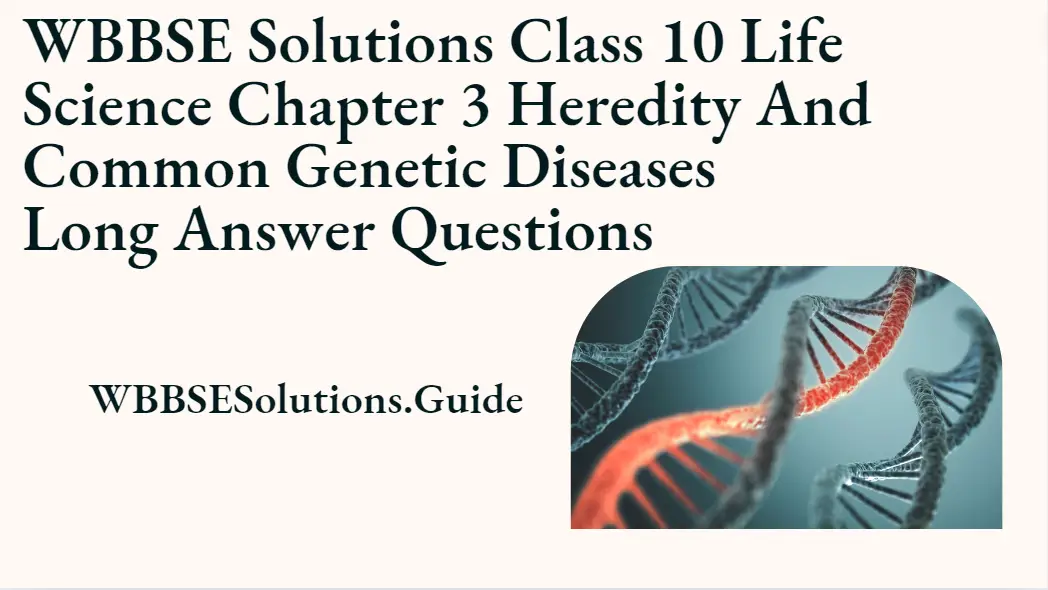
“WBBSE Class 10 Life Science Chapter 3 solutions, Heredity and Common Genetic Diseases, long answer questions”
Question 2. Explain what would be the ratio of the pure red and pure white flower-bearing pea plants in the F, generation when a cross is made between two pea plants: one pure red flower (dominant) and the other bearing pure white flower (recessive).
Answer:
(1) Monohybrid cross between pure red and pure white pea plant flower:-
Two pea plants, one bearing pure red flower and another bearing pure white flower, are selected. Flowers appear on both plants at the same time. These plants are considered as peas plants is bisexual plants. So, to check the self-pollination the anther of the flower of one plant is cut and the stigma of the other plant is covered with a paper. Now artificial cross-pollination is done. As a result of this, the seeds for F, are obtained. When these seeds are sown all the plants bear red flowers. These are the plants of the F, generation. When the plants of F, bear flower, self-pollination is allowed. As a result of this action seeds for F, are obtained when these seeds germinate. Now plants are produced. These plants are called the F, generation plants. The colour of flowers in all the plants of the F, generation is not red. The genotypic ratio of F, generation is 1: 2: 1. So, the ratio of pure red and pure white flowers in F, generation is 1: 1.
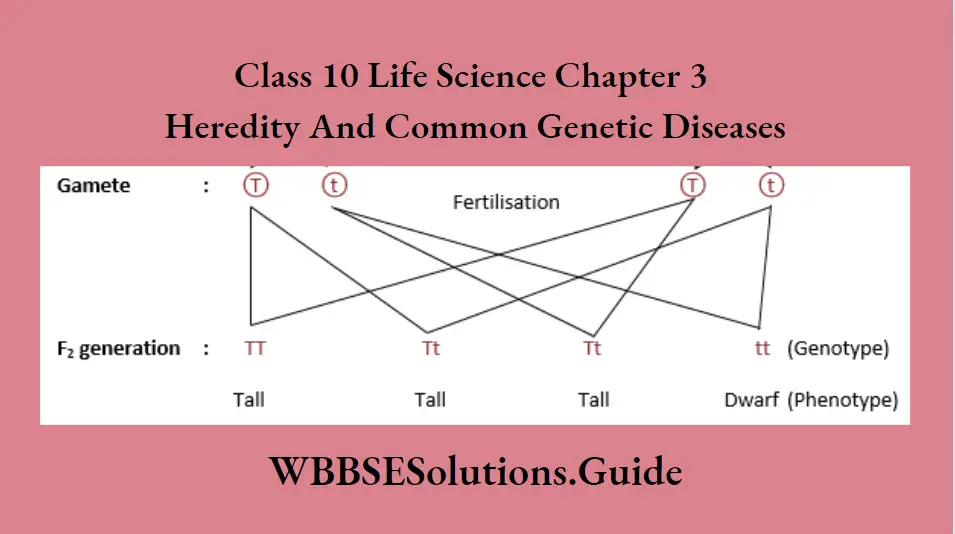
Question 3. How did Mendel explain the occurrence of tallness of all pea plants in the F, generation in his experiment on monohybrid cross? Discuss in brief how he also explained the occurrence of growing tall and dwarf pea plants in the ratio of 3: 1 in the F, generation in the same experiment.
Answer:
(1) Explanation of occurrence of all tall plants in F, generation of Mendel’s monohybrid experiment:- Mendel selected two sets of pea plants. One set consisted of tall plants (50cm – 200 cm in height) and the other of short plants (up to 50 cm in height). He first made it certain that seeds from tall plants invariably produced tall plants and the dwarfs produced only the dwarfs in successive generations, that is, they are true breeding. He then artificially cross-fertilized tall plants with dwarf plants of the parental generation. To achieve this, he removed the anther of tall plant and covered the stigma of the dwarf plant Then he dusted the pollen grains of a dwarf plant to the stigma of the tall plant. He also made reciprocal crosses. So that each one had a chance to set as male and female parent. He collected all seeds upon ripening and raised the hybrid from these seeds. He referred to this generation as F, All plants of this generation were tall.
Mendel explained the reasons behind the occurrence of all tall plants in F, He suggested that each parent contributed a factor to the offspring. This factor was later termed a gene. The factor contributed by the tall parent was dominant over the factor of dwarfness. He suggested that though both factors were present in the F, the dwarf factor remained unexpressed as it was masked by the factor for tallness.
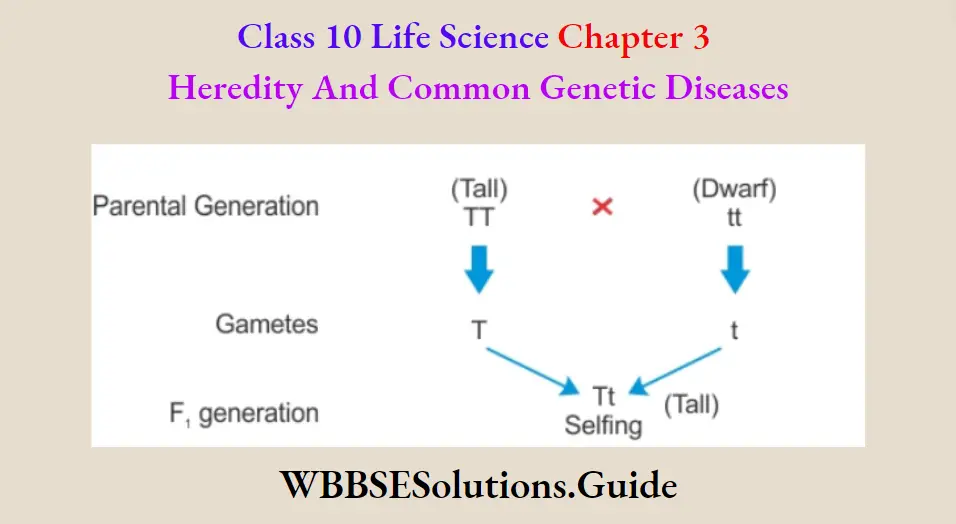
(2) Explanation of the occurrence of tall and dwarf plants in the ratio of 3: 1 in F, generation in the same experiment:・He allowed individuals of F, for self-pollination and subsequently self-fertilization occurred. These self-fertilized seeds are sown in the field for germination. He observed that all the plants were not tall, rather some of the plants became dwarf. So, the tall and dwarf plants were designated as F, generation. Mendel observed that 75% of plants became tall and 25% of plants became dwarf in the F, generation. The ratio of tall and dwarf plants is 3: 1. It was found that the dwarf of F, the generation when self-pollinated was true-breeding, while of the tall plants, only 25% were true breeding. The remaining 50% of the tall plants in the
next generation, produce tall and dwarf plants in the ratio of 3: 1.
In the F, generation, however, the characters segregated and produced tall and dwarf plants. Based on these observations, Mendel postulated the law of segregation, which stated that pairs of contrasting characters of a hybrid separate from each other in subsequent generations.
Question 4. Write the first and second laws of Mendel related to heredity in the form of a definition.
Answer:
First Law of Mendel (Law of Segregation):・Whatever factor may come together in the zygote, they never lose their identity and the factors or genes making up the pair are separated at meiosis during the formation of gametes to produce the next generation. Thus, each gamete contains one factor or gene for a character but the paired form is restored after fertilization.
Second Law of Independent Assortment:- Two or more pairs of factors coming together in the F, separate at meiosis and combine in various ways forming the plants in F and succeeding generations and each pair of factors is inherited independently of the other.
“West Bengal Board Class 10 Life Science Chapter 3, long answer questions, with solutions”
Question 5. Explain the terms dominant and recessive characters, phenotype and genotype with the help of Mendel’s monohybrid cross experiment.
Answer:
Mendel’s monohybrid cross experiment:- Mendel selected two sets of garden pea plants. One set consisted of pure tall plants and the other of pure dwarf plants. He then cross-pollinated tall plants with dwarf plants artificially. He also made reciprocal crosses. He collected all the seeds. He sowed them in the field for germination. He observed that all the plants were tall. He called them the F, generation.
The tall plants of F, generation were allowed for self-pollination and subsequently for self-fertilization. Again, seeds are collected and sown in the garden field for germination. He observed that all the plants were not tall. Some of the plants became dwarfs. He called them as F, generation. Mendel observed that in the F, generation 75% of plants became tall and 25% became dwarf. The ratio of tall and dwarf plants is 3: 1. It was found that the dwarf of F, the generation when self-pollinated was true-breeding, while of the tall plants, only 25% were true breeding.
The remaining 50% of the tall plants in the next generation produce tall and dwarf plants in the ratio of 3: 1.
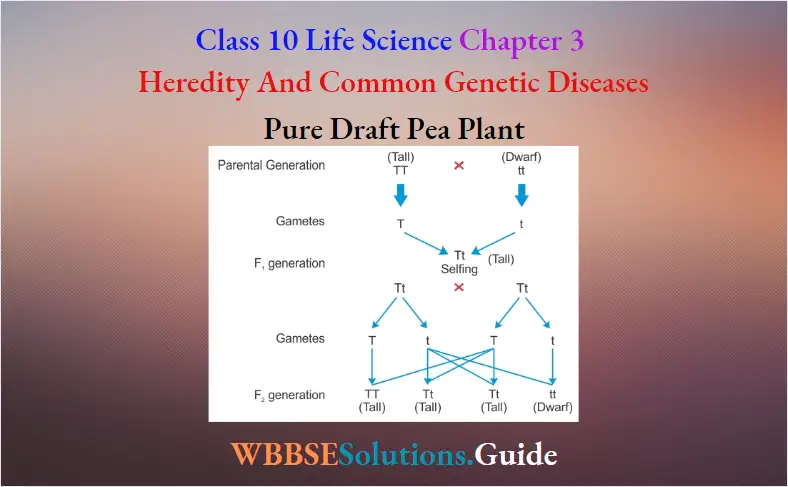
Based on the observations of the monohybrid cross, we can clarify some points:-
(1) F, generation obtains one factor from the pure tall plant and another factor from the pure dwarf plant. It has both factors for a single character’s tallness. Hence it is a hybrid. Here only the pure tall factor expresses itself. So, this plant is a hybrid tall. The pure dwarf factor is unable to express itself.
(2) The factors of a hybrid are segregated during the formation of gametes to produce the next generation. A gamete contains only one factor for a character. Thus, it is clear that a gamete is always pure.
Keeping the above facts in view, we can define the following terms in this way:-
(1) Dominant:・The factor present in a hybrid expresses itself in a generation is called dominant. Such as tall (TT) factor is a dominant factor of tallness character.
(2) Recessive:・The factor present in a hybrid unable to express itself in a generation is called recessive. Such as dwarf (tt) factor is a recessive factor of tallness character.
(3) Phenotype:- The characteristic of an organism which is externally visible is called phenotype. Example – In F, generation the phenotype of three plants is tall and one plant is dwarf.
(4) Genotype:- The characteristic of an organism which is given based on its entire genetic constitution is called genotype. Example ・In F, generation one plant is pure tall (TT), two plants are hybrid tall (Tt) and the last plant is pure dwarf (tt).
“Class 10 WBBSE Life Science Chapter 3 long answers, for board exam preparation”
Question 6. Mention Mendel’s dihybrid cross experiment with the help of a checkerboard and also mention the phenotypic ratio of the F, generation based on the experimental results.
Answer:
A cross between two sets of plants involving two pairs of contrasting characters is called a dihybrid cross.
Experiment:- For this cross, Mendel selected two plants. One plant possesses round and yellow seeds while another plant possesses wrinkled and green seeds. He arranged artificial cross-pollination. Seeds obtained from this cross were round and yellow. So these factors are dominant, while the wrinkled and green factors are recessive. He called them seeds of the first filial generation (F,).
Plants obtained from these seeds were allowed for self-pollination. They yielded four types of seeds : (1) Round and yellow, (2) Wrinkled and yellow, (3) Round and green, and (4) Wrinkled and green. }
These results are explained by a factor pair Y-y for yellow-green and another factor pair R-r for round-wrinkled. The round and yellow parent can be written as RRYY and the wrinkled and green parent as rryy, the first parent produces gametes which are Ry and the gametes of the second parent are ry. When these gametes unite, the resulting F is RrYy. As round (R) and yellow (Y) factors are dominant over wrinkled (r) and green (y) factors, the F is a hybrid round and yellow.
When the F, in turn, produces gametes, all combinations occur at the time of meiosis. Therefore, both among male and female gametes, four types of gametes RY, ry, Ry and ry are produced. The male and female gametes unite truly and produce a second filial generation (F,). The phenotypic ratio of this generation is 9:3:3: 1.
(Dihybrid cross between pea plants having round yellow seeds and wrinkled green seeds.)
Question 7. State the modern concept of heredity.
Answer:
(1) Characters of parents are transmitted to the progeny through sperms and ova.
(2) Chromosome numbers in each species are constant.
(3) Sperms and ova carry half the number of chromosomes of that species.
(4) Genes are present on chromosomes in a single linear order.
(5) Each gene is present in a particular position of a chromosome.
(6) Gene is composed of DNA.
(7) Gene has the capacity of self-duplication and also mutation.
(8) The fundamental material of heredity is the gene.
(1) Genes are the bearer of hereditary characters.
Question 8. Describe the monohybrid cross experiment in animals (Guineapig).
Answer:
To perform a monohybrid cross a black hair guineapig and a white hair guinea-pig are. selected. Now a cross is allowed. In the F, generation all the offspring are black. From this, it is concluded that the black colour is dominant over the white colour.
Now a cross is made between an adult male and a female of the F, generation. In the F, generation, black and white coloured guineapigs are produced in the ratio of 3: 1.
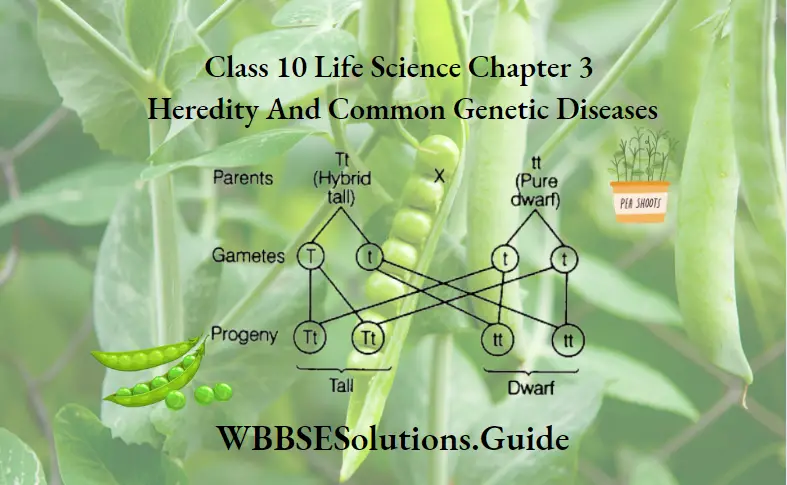
Question 9. Describe dihybrid cross in animals.
Answer:
Dihybrid cross in animals:
Two different-sex guinea pigs are selected. One has pure black and rough hair while another has white and smooth hair. Now, a cross is allowed. All the F, offspring are black and rough-haired.
Now, F, hybrids are interbred. They will produce 16 offspring in F, generation in the ratio 9:3:3:1
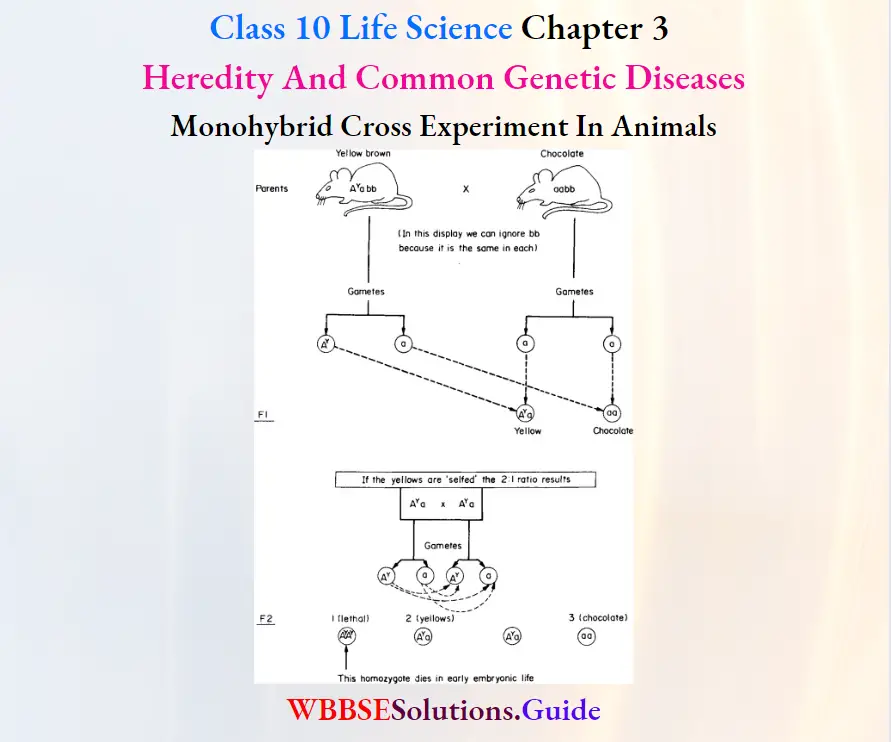
Dihybrid experiment on guineapig
Black and Rough = 9
Black and Smooth = 3
White and Rough = 3
White and Smooth = 1
Phenotypic ratio =9:3:3:1
“Class 10 WBBSE Life Science Chapter 3 long answer questions, Heredity and Genetic Diseases”
Question 10. Explain how the sex of a child is established.
Answer:
Sex of a child is established as follows:
Sex is a characteristic which is transmitted from parents to offspring. Genes are grouped to form chromosomes. The human species has twenty-three pairs of chromosomes. With one exception, the twenty-two members of each pair of chromosomes are alike. The exception is the pair which determines sex always referred to as the sex chromosomes. The somatic cells of the female have a pair xx but the somatic cells of the male have a pair of sex chromosomes which are not alike, xy, y being much smaller than x. Each gamete gets only one sex chromosome; all the ova have x but half the sperms have x and the other half y.
Allowing for every possibility, in the fusion of the gametes the chances are equal that an ovum will be fertilized by x x-bearing sperm or a y-bearing sperm. But the resulting zygote has its sex determined at the moment of fertilization. If xx chromosomes are present the child will be a girl, if xy are Present the child will be a boy.
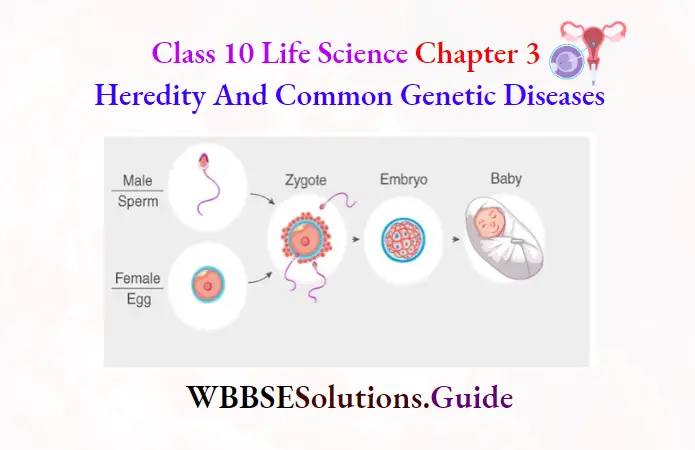
Question 11. Write four reasons for selecting pea plants by Mendel for his experiments on heredity. Explain with reasons which one between sperm and ovum
is responsible for the determination of sex in human beings.
Answer:
Reasons for selecting pea plants by Mendel for his experiments on heredity
(1) Mendel selected garden peas as his experimental material because
(1) Sweet pea plant is an annual plant. :
(2) It has a large number of pairs of contrasting characters.
(3) Its flowers are complete and bisexual. So it avoids the problems of pollination.
(4) Reproduction ability is excess. :
(2) Explanation to show between sperm and ovum which one is responsible for the determination of sex in human beings:- Sex is a character which is transmitted from parents to offspring. Genes are grouped to form chromosomes. The human species has twenty-three pairs of chromosomes. With one exception, the twenty-two members of each pair of chromosomes are alike. The exception is the pair which determines sex, always referred to as the sex chromosomes. The somatic cells of the female have a true pair xx but the somatic cells of the male have a pair of sex chromosomes which are not alike, xy, y being much smaller than x. Each gamete gets only one sex chromosome; all the ova have x but half the sperms have x and the other half y.
“Heredity and Common Genetic Diseases WBBSE Class 10, long answer questions, solved answers”
Allowing for every possibility, in the fusion of the gametes the chances are equal that an ovum will be fertilized by x x-bearing sperm or a y-bearing sperm. But the resulting zygote has its sex determined at the moment of fertilization. If xx chromosomes are present the child will be a girl, if xy are present the child will be a boy. So, sperm is responsible for the determination of sex.
Question 12. Write the full name of the Father of Genetics. What are phenotype and genotype? If a YYRR (pure dominant yellow and round seeded) pea plant is hybridised with a year (pure recessive green and wrinkle seeded) pea plant, what will be the genotype of the plants obtained in F, generation? Write the phenotypic ratio obtained in the F, generation in the said dihybrid cross.
Answer:
Father of Genetics
(1) Gregor Johann Mendel.
(2) Phenotype:- An organism’s externally visible characteristics are called phenotype. Example = In F, generation of monohybrid cross the phenotype of three plants is tall and one plant is dwarf.
(3) Genotype:- The characteristics of an organism which are given based on its entire genetic constitution are called genotype. Example ・In F, generation of a monohybrid cross one plant is pure tall (TT), two plants are hybrid tall (Tt) and the last plant is a pure dwarf (tt)
(4) The genotype of F, plants will be RrYy
(5) The phenotypic ratio of F, generation is 9:3:3: 1,
Question 13. What is a hybrid? If a hybrid black-haired Guineapig is crossed with a white-haired Guineapig, what will be the phenotypes of the Guineapigs of the First filial (F,) generation and why? Explain with reasons.
Answer:
Hybrid – An organism having two different genes (contrasting genes) affecting the same trait is called a hybrid.
50% Hybrid black-haired guinea pig and 50% white-haired guinea pig will be produced because Black hair is dominant over White hair.
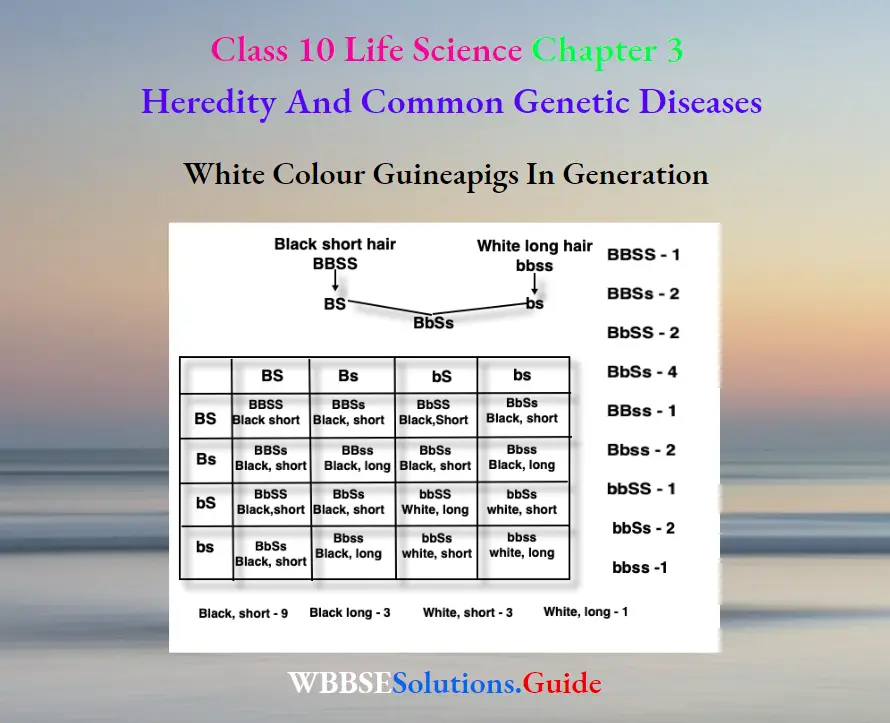
Question 14. Write seven pairs of contrasting characters in pea plants selected for Mendel’s experiments.
Answer:
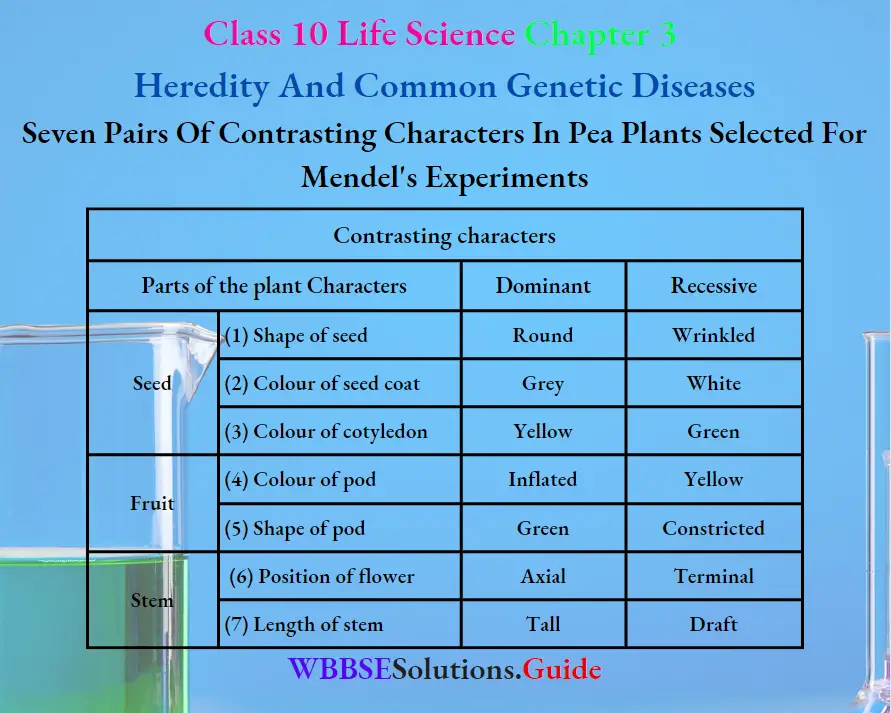
Question 15. In which name is the first law known Explain with a checkerboard the experiment Mendel performed to reach that conclusion.
Answer:
(1) The first law is known as the law of segregation.
(2) Explanation:- Mendel selected two sets of pea plants. One set consisted of tall plants (50cm – 200 cm in height) and the other of short plants (up to cm in height). He first made it certain that seeds from tall plants invariably produced tall plants and the dwarfs produced only the dwarfs in successive generations, that is, they are true breeding. He then artificially crisscross-fertilized plants with dwarf plants of the parental generation. To retrieve this, he removed the anther of tall the plant and covered the stigma of the dwarf plant. Then he dusted the pollen grains of a dwarf plant to the stigma of the tall plant. He also made reciprocal crosses, so that each one had a chance to set as male and female parent. He collected all seeds upon ripening and raised the hybrids・from these seeds. He referred to this generation as F, A, plants of this generation were tall.
“WBBSE Class 10 Life Science Chapter 3 important long answer questions, exam-focused solutions”
Mendel explained the reasons behind the occurrence of all tall plants in F, He suggested that each parent contributed a factor to the offspring. This factor was later termed a gene. The factor contributed by the tall parent was dominant over the factor of awareness. He suggested that though both factors were present in the F, the dwarf factor remained unexpressed as the factor for tallness masked it.

He allowed individuals of F, for self-pollination and subsequently self-fertilization occurred. These selfself-fertilizedds are sown in the field for germination. He observed that all the plants were not tall, rather some of the plants became dwarf. So, the tall and dwarf plants were designated as F, generation. Mendel observed that 75% of lants became tall and 25% of plants became dwarf in the generation. The ratio of tall and dwarf plants is 3: 1. It was found that the dwarf of F, generation when self-pollinated were true breeding, while the tall plants only 25% were true breeding. The remaining 50% of the tall plants in the next generation, produce tall and dwarf plants in a ratio of 3: 1.
In the F, generation, however, the characters segregated and produced tall and dwarf plants. Based on these observations, Mendel postulated the law of segregation, which stated that pairs of contrasting characters of a hybrid separate from each other in subsequent generations.
Question 16. Explain Mendel’s second law of heredity with the help of the dihybrid cross experiment by Mendel. If a sperm containing the X-chromosome of a man fertilizes an ovum of a woman, what will be the sex of the child developing from the resulting zygote?
Answer:
(1) Experiment:- For this cross, Mendel selected two plants. One plant possesses round and yellow seeds while another plant possesses wrinkled and green seeds. He arranged artificial cross-pollination. Seeds obtained from this cross were round and yellow. So these factors are dominant, while the wrinkled and green factors are recessive. He called them seeds of the first filial generation (F,).
These results are explained by a factor pair Y-y, for yellow-green and another factor pair, R-r for round-wrinkled. The round and yellow parent can be written as RRYY and the wrinkled and green parent as rryy, the first parent produces gametes which are Ry and the gametes of the second parent are ry. When these gametes unite, the resulting F is RrYy. As round (R) and yellow (Y) factors are dominant over wrinkled (r) and green (y) factors, the F is a hybrid round and yellow.
When the F, in turn, produces gametes, all combinations occur at the time of meiosis. Therefore, both among male and female gametes, four types of gametes RY, ry, Ry and ry are produced. The male and female gametes unite truly and produce a second filial generation (F,). They yielded four types of seeds :
(1) Round and yellow,
(2) Wrinkled and yellow,
(3) Round and green,
(4) Wrinkled and green.
The phenotypic ratio of this generation is 9: 3:3: 1.
(2) Second Law or Law of Independent Assortment Two or more pairs of factors coming together in the F, separate to meiosis and combine in various ways forming the plants in F, and succeeding generations and each pair of factors inherited independently of the other.
(3) The child will be female.
“Best long answer questions for WBBSE Class 10 Life Science Chapter 3, solved Q&A”
Question 17. What do you understand by the terms homozygous・and Heterozygous・conditions? Explain the law of Independent Assortment.
Answer:
(1) Homozygous – The individual having a genotype, with two of the same alleles for a trait is called Homozygous.
Example – TT or tt
(2) Heterozygous – The individual having a genotype, with distinct alleles for the same trait is called Heterozygous.
Example – Tt.
(3) Law of Independent Assortment – When two or more pairs of factors come together in the F, separate at meiosis and combine in various ways forming the plants in the F, and succeeding generations and each pair of factors is inherited independently of the other.
Question 18. Black hair is dominant and white hair is a recessive character of guineapig. Explain the result of a cross between two hybrid black guineapigs with the help of a checkerboard. What types of gametes unite to form a female child in man?
Answer:
(1) When hybrid black Guineapigs are interbred they will produce 75% black colour and 25% white colour Guineapigs in F, generation. The phenotypic ratio of this generation is 3: 1, while the phenotypic ratio is 1: 2: 1.
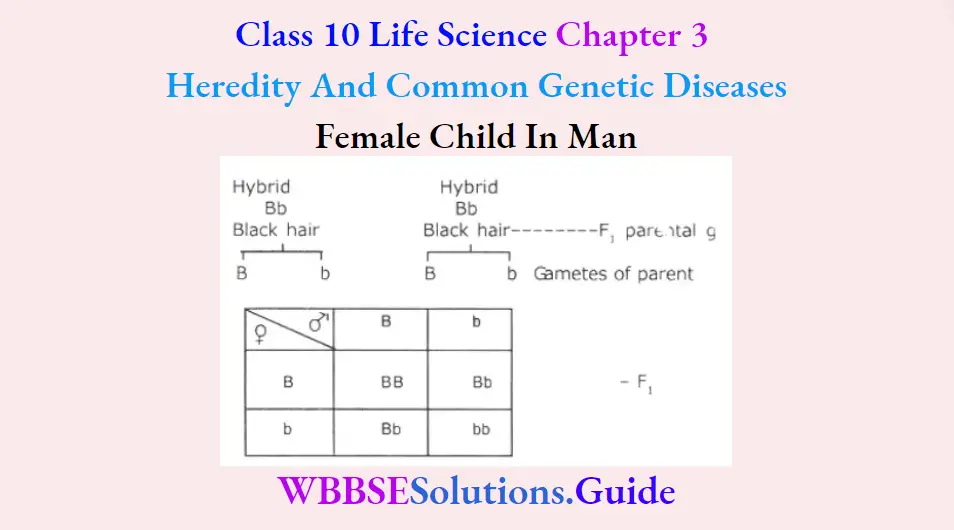
(2) Female gamete ovum contains (22x+x) chromosome. Male gamete sperm also contains (22x+x) chromosome. These two gametes unite to form a female child.
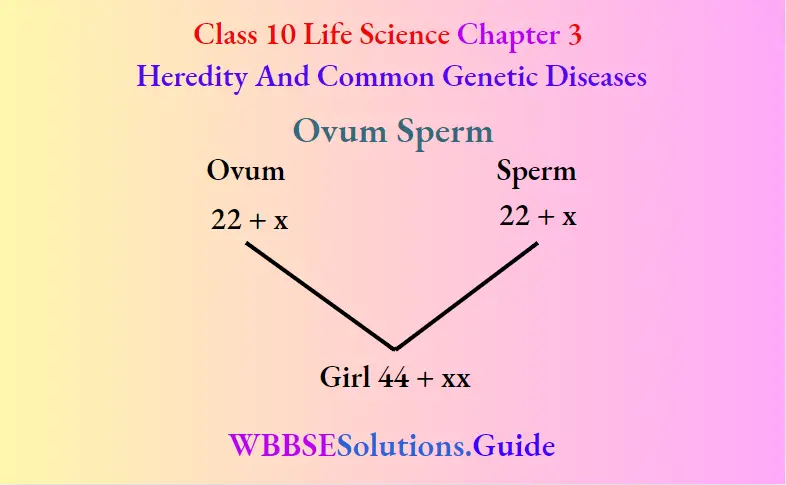
Question 19. Briefly explain the following behavioural adaptations :
(1)Problem-solving in chimpanzees,
(2) Communication in honeybees.
Answer:
(1) Problem-solving chimpanzees: Just like humans, chimpanzees create and use tools to make their lives easier. Termites are one of the himpanzees・favorite foods, but how to reach the creatures deep within their mounds presents quite a problem. Chimpanzees pick up a twig and stripe the leaves off of it Then they stick the twig into one of the holes in the termite mound, leave it there for a moment, and slowly pull it out as termites clung to the twigs they pick them off with their lips and scrunched them. They are using the stem as a tool to fish・for insects. Chimpanzees have also been seen using tools such as stone hammers to chop up and reduce food into smaller bite-sized portions. Chimpanzees like eating nuts. They hammer them open with stone or wood.
Non-human primates especially chimpanzees-self-medicate. Chimpanzees in the wild appear to practice herbal medicine. They consume numerous items with medicinal properties, such as anti-bacterial agents and deworming herbs.
“WBBSE Class 10 Life Science Heredity and Common Genetic Diseases, detailed long answer questions”
(2) Communication in honeybees Perhaps the most famous and fascinating language of the honey bee is communicated through a series of dances done by
foraging worker bees who return to the hive with news of nectar, pollen, or water. The details of the dance languages were worked out by Karl von Frisch (1967). Two common types of dances are the so-called round dance and the waggle dance. The dance in a figure-eight (8) patterns. It involves a shivering side-to-side motion of the abdomen. The bee first runs straight ahead for a precise distance wagging her
Question 20. Explain in brief the dominant and recessive characters from the result of Mendel’s monohybrid cross experiment in the pea plant. What is genotype?
Answer:
(1) Mendel’s monohybrid cross experiment ・Mendel selected two sets of garden pea plants One set consisted of pure tall plants and the other of Pure dwarf
plants He then cross-pollinated all plants with dwarf plants artificially. He also made reciprocal crosses. He collected all the seeds. He sowed them in the field for germination. He observed that all the plants were tall. He called them the F, generation. Based on observations of the Monohybrid cross we can Clarify some points:-
(1) F, generation obtains one factor from the pure tall plant and another factor from the pure dwarf plant. It has both the factors for single character tallness. Hence it is a hybrid. Here only the Pure Tall factor expresses itself. So this plant is a hybrid tall. The pure dwarf factor is unable to express itself. Keeping the above facts in view, we can define the following terms in this way:-
(1) Dominant:- The factor present in a hybrid expresses itself in a generation is called dominant. Such as the tall (TT) factor is a dominant factor of tallness character.
(2) Recessiv:- The factor Present in a hybrid unable to express itself in a generation is called recessive. Such as the dwarf (tt) factor is a recessive factor of tallness character.
Genotype The genetic constitution of an organism is called genotype. Example-Pure tall (TT), hybrid all- Tt, pure dwarf-tt.
Question 21. Why did Mendel select pea plants for his experiments? Mention any three reasons for it. What is hybridisation? Why is Mendel called the father of genetics? What do you mean by character
Answer:
Mendel selected garden peas as his experimental material because ・;
(1) These are annual self-fertilised plants with bisexual flowers.
(2) The plants could be grown easily and crossing could be done without any difficulties.
(3) The hybrid plant obtained from the cross between two varieties of pure plants ais completelyfertile.
The artificial process which is used to produce hybrid is called hybridization. He performed cross-breeding experiments on sweet pea plants analysed the records obtained from observations and formulated them in the form of laws.
Any inheritable feature is called a character.
